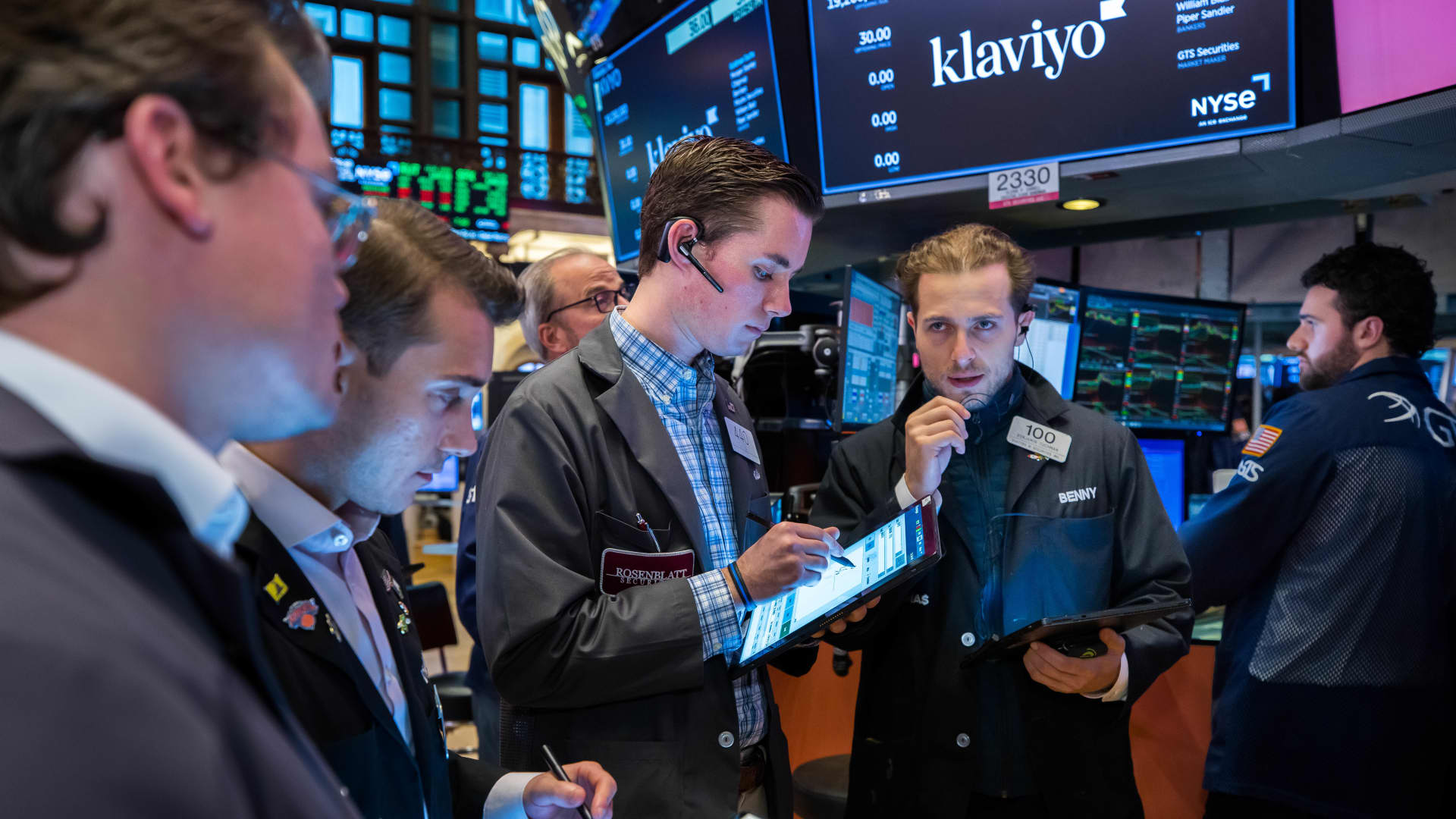[ad_1]
Traders working on the New York Stock Exchange (NYSE), on September 20, 2023.
NYSE
It’s quiet in IPO land – very quiet.
Here it is: The weeks before Thanksgiving usually bring a flurry of large IPOs eager to go public before the holidays begin.
“Whatever you’re going to get between now and the end of the year, it should happen now,” Don Short, head of venture equity at InvestX, told me.
Except nothing happens.
“The bad companies can’t go public, and the good companies don’t want to go public in a bad market,” says Matt Kennedy of Renaissance Capital.
A terrible performance for stocks in October, higher interest rates, poor after-market performance after the recent wave of IPOs this summer and the prospects of dramatically lower valuations appear to be causing many IPO candidates to reconsider or delay their plans. debuts.
The steady rise in yields on ten-year government bonds was a deal killer in particular.
“That was a big wet blanket” for the IPO market, Greg Martin of Rainmaker Securities told me.
Companies are postponing IPOs
Waystar, which was considering launching its roadshow last week, is reportedly postponing its IPO until December or until 2024.
Last week, the Wall Street Journal reported that Panera Bread was laying off 17% of its corporate workforce ahead of a possible IPO next year.
Others still interested in an IPO may have to make very big cuts.
Buy now, pay later firm Klarna, another oft-mentioned IPO candidate, told CNBC it has no immediate plans to go public. The company last raised cash at a valuation of $6.7 billion, which marked a massive 85% reduction from its previous valuation of nearly $46 billion.
Chinese fast-fashion giant Shein has not yet decided on the timing or valuation of an initial public offering, but sources familiar with the company’s plans told Bloomberg that the company is targeting a valuation of $80 billion to $90 billion. However, its most recent funding round in May valued the company at $66 billion.
This is in stark contrast to most years, when major IPOs went public in November and December.
Rivian, the largest IPO of 2021, priced on November 9, 2021 and began trading the next day. Hertz raised $1.3 billion in November 2021. Braze raised $500 million that same month, Sweetgreen raised $364 million. Allbirds raised $303 billion.
Airbnb went public in December 2020 and raised $3.5 billion. The day before, Doordash raised $3.4 billion. A month earlier, in November 2020, Sotera Health raised $1.1 billion, and Miravai Life Sciences raised $1.6 billion.
But the year-end gold rush trickled into 2022, and it’s trickling again this year.
So far in 2023, 96 IPOs have raised $18.8 billion, according to Renaissance Capital. That follows 2022, which raised a paltry $7.7 billion, the worst year for IPOs in decades. In contrast, in a normal year at least $50 billion would have to be raised.
Recent IPOs don’t help
It didn’t help that the recent wave of IPOs hasn’t gone well.
“What I heard was that everyone in line after Instacart was going public [in September] pulled their deal and everything kind of went quiet,” Short told me.
Three of the year’s biggest IPOs are trading below their offering prices, and a fourth, Arm, is trading near its debut price after falling below that in early trading on Thursday.
Largest IPOs, 2023
(from bid price)
Arm approximately flat
Kenvue decrease of 13%
Birkenstock decrease 8%
Instacart decrease of 10%
Source: Renaissance Capital
Marketing automation company Klaviyowhich went public in September, is also trading 8% below its $30 offering price after reporting earnings on Tuesday.
Restaurant chain Cava group went public in June and is trading $31 above its initial offering price of $22, but the stock was as high as $57 in the month after it went public, so at Wednesday’s price of $31 most of the original buyers of the stock after opening are underwater.
The Renaissance Capital IPO ETF (IPO)a basket of roughly 60 of the largest IPOs of the past two years, is down 17% from a July peak to an October trough. S&P wasn’t that bad, but showed a similar trajectory.
Some companies can still go public
The market is not completely closed.
“I wouldn’t discount December. If the last rally continues, we could see more activity,” Kennedy said. “Companies want to go public when there is an expectation that the market will rise.”
There are still some small companies in the pipeline.
US natural gas producer BKV, which filed for a $100 million IPO last November, recently updated its prospectus, signaling that it is still looking to go public.
Homebuilder Smith Douglas, which filed for a $100 million initial public offering in September, also updated its prospectus in mid-October.
American Healthcare REIT, filed September 2022, filed updated financials and announced an additional underwriter (Morgan Stanley) this week.
Here’s another problem: AI
So what happens to some of the older IPO candidates like Reddit or Stripe? As time goes by, they become less interesting.
“The excitement right now is in the AI space, but none of them are ready to go public yet,” Short said. “There are still a lot of names burning money, but there isn’t a lot of capital available right now for anything that isn’t AI.”
That’s the main reason Arm is one of the few IPOs that hasn’t fallen sharply.
“Anything related to AI is a whole different category, and Arm is definitely going to have a halo effect,” Short said. Arm reported its first profit as a publicly traded company on Wednesday evening. Shares fell about 7% in trading on Thursday after offering a weak outlook.
Difficult choices for IPO candidates
That leaves IPO candidates with three choices: 1) go public, probably with a significant haircut, 2) stay private, probably also with a haircut, and hope your venture capital source will continue to fund you, or 3) merge or disappear from Affairs.
Greg Martin of Rainmaker Securities runs one of the leading private platforms for trading pre-IPO companies. He told me that the companies in the best position are those that can finance their operations from their own cash flow, but that is not a large group.
“The private financing markets are even worse than the public financing markets, so you really don’t want to run out of cash right now,” Martin said, adding that he sees much lower prices for private stock sales compared to two others. years ago.
That puts many of the roughly 800 tech unicorns (those with valuations above $1 billion) in a precarious position.
“We’re starting to see unicorns dying,” Martin said. “There are many lower quality unicorns with negative EBIDTA [cash flow]and there is not much demand for them in the public markets, so the M&A route is becoming increasingly likely for many companies.”







